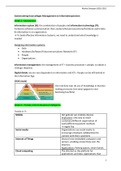Marlie Snoeijen 2020-2021
Samenvatting hoorcolleges Management en Informatiesystemen
Week 1 - Introduction
Information system (IS): the combination of people and information technology (IT):
hardware-software-communication that create/collect/process/store/distribute useful data
& information in an organization.
→ To build effective Information Systems, we need to understand what knowledge is
needed
Designing information systems:
• Data
• Hardware/Software/Telecommunications Networks (IT)
• People
• Organizations
Information management: the management of IT + business processes + people, to obtain a
strategic objective
Digital divide: we are very dependent on information and ICTs. People can be left behind in
the Information Age.
DIKW model
Van raw data naar de use of knowledge in decision
making processes (van weer-gegevens naar
beslissing bus/fiets)
Week 2 – Trends, intro to Business Intelligence
Trends in IT:
Mobile Het gebruik van mobiele devices
Implicaties: new way to reach
customers/different organization of
work/different payment methods
→ Apple Pay
Social media Organizations use social media to
encourage employee collaboration/to
connect with their customers
Internet of Things Devices have embedded computers and
sensors, enabling connectivity over the
Internet.
Applications: Parking spaces, smart homes
Cloud computing The Internet as the platform for
applications and data. Applications that
1
, Marlie Snoeijen 2020-2021
used to be installed on individual
computers increasingly kept in the cloud.
→ Gmail, docs, Calendar, MS Azure
Big data & business analytics 5 V’s: volume-variety-velocity-veracity-
value
E-commerce Business, consumer, government (B2B, B2C,
C2G)
Recommender systems: systems that seek
to predict the rating/preference that a user
would give to an item (‘Consumers who
bought this also bought this’)
Dynamic pricing: flexible prices for
products/services based on current market
demands
Artificial Intelligence Two basic ideas:
• Studying the thought processes of
humans
• Representing & duplicating these
processes via machines
→ Chat bot
Blockchain A shared digital database to specify
contracts/transactions
• Fiddling with transactions not
possible (real-time copy)
→ Cryptocurrencty (Bitcoin)
→ Smart contracts: automated contracts
via blockchain, blockchain as trustmachine
(voting machines, registration of property,
savings account)
Introductie Business Intelligence/analytics
Data management: managing data as a valuable resource
→ Data production, assembly/logistics/storage, processing/analysis/consumption
Business intelligence: transforming data into meaningful information/knowledge to support
business decision-making
→ Van ruwe data naar iets bruikbaars/aantrekkelijks
1. Data
Items that are the most elementary descriptions of
things/events/activities/transactions.
→ Intern/extern, gestructureerd/ongestructureerd
Nominaal: geen volgorde (man/vrouw, marital status)
Ordinal: wel volgorde (laag-hoog)
2
, Marlie Snoeijen 2020-2021
Interval: equal intervals, géén natuurlijk nulpunt (Celsius,
order date)
Ratio: natuurlijk nulpunt (Kelvin, sales, cost per order)
2. Information
Organized data that has meaning and value
3. Knowledge
Processed data/information that is applicable to a business decision problem
Business intelligence methods:
Descriptive analytics Use data to understand past & present
→ Reporting, dashboards
Predictive analytics Predict future behavior based on past
performance
→ Historische database
Prescriptive analytics Make decisions/recommendations to
achieve best performance
→ Econometrie
Week 3 – Business process modeling 1
Business process: a set of activities that jointly realize a business goal
→ Sale of products, purchase of materials, order-to-cash
Business process management: concepts, methods & techniques to
support the design, administration, configuration, enactment and
analysis of business processes.
→ We’re focusing on the operational business processes (Petri Net)
Voor een model is een information system en operational process nodig.
_________________________________________________________________
A process/workflow/procedure specifies:
• Which steps are required
• In what order
→ Purchase order process, tax declaration process, insurance claims process
3 elements:
Tasks/transition • A logical unit of work
• A task is atomic: commit/rollback
• Actief
• Altijd een naam!
→ Een order plaatsen, een bestelling doen
3






